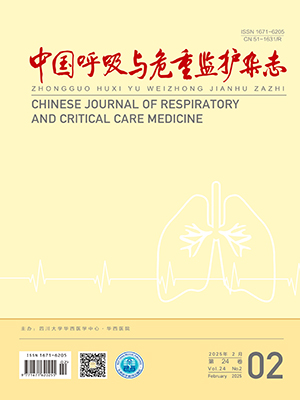| 1. |
Dres M, Dubé BP, Mayaux J, et al. Coexistence and impact of limb muscle and diaphragm weakness at time of liberation from mechanical ventilation in medical intensive care unit patients. Am J Respir Crit Care Med, 2017, 195(1): 57-66.
|
| 2. |
Bissett BM, Wang J, Neeman T, et al. Which ICU patients benefit most from inspiratory muscle training? Retrospective analysis of a randomized trial. Physiother Theory Pract, 2020, 36(12): 1316-1321.
|
| 3. |
Hearn E, Gosselink R, Freene N, et al. Inspiratory muscle training in intensive care unit patients: an international cross-sectional survey of physiotherapist practice. Aust Crit Care, 2022, 35(5): 527-534.
|
| 4. |
Worraphan S, Thammata A, Chittawatanarat K, et al. Effects of inspiratory muscle training and early mobilization on weaning of mechanical ventilation: a systematic review and network meta-analysis. Arch Phys Med Rehabil, 2020, 101(11): 2002-2014.
|
| 5. |
Elkins M, Dentice R. Inspiratory muscle training facilitates weaning from mechanical ventilation among patients in the intensive care unit: a systematic review. J Physiother, 2015, 61(3): 125-134.
|
| 6. |
Bissett B, Leditschke IA, Green M, et al. Inspiratory muscle training for intensive care patients: a multidisciplinary practical guide for clinicians. Aust Crit Care, 2019, 32(3): 249-255.
|
| 7. |
Bissett B, Gosselink R, Van Haren FM. Respiratory muscle rehabilitation in patients with prolonged mechanical ventilation: a targeted approach. Crit Care, 2020, 24(1): 103.
|
| 8. |
Vorona S, Sabatini U, Al-Maqbali S, et al. Inspiratory muscle rehabilitation in critically ill adults. A systematic review and meta-analysis. Ann Am Thorac Soc, 2018, 15(6): 735-744.
|
| 9. |
Bissett BM, Leditschke IA, Neeman T, et al. Does mechanical threshold inspiratory muscle training promote recovery and improve outcomes in patients who are ventilator-dependent in the intensive care unit? The IMPROVE randomised trial. Aust Crit Care, 2023, 36(4): 613-621.
|
| 10. |
Caruso P, Denari SD, Ruiz SA, et al. Inspiratory muscle training is ineffective in mechanically ventilated critically ill patients. Clinics, 2005, 60(6): 479-484.
|
| 11. |
Mohammed S, Elbouhy MS, Abdelhalim HA, et al. Effect of respiratory muscles training in weaning of mechanically ventilated COPD patients. Egypt J Chest Dis Tuberc, 2014, 63(3): 679-687.
|
| 12. |
Rosa D, Negro A, Marcomini I, et al. The effects of early mobilization on acquired weakness in intensive care units: a literature review. Dimens Crit Care Nurs, 2023, 42(3): 146-152.
|
| 13. |
Dres M, Goligher EC, Heunks LMA, et al. Critical illness-associated diaphragm weakness. Intensive Care Med, 2017, 43(10): 1441-1452.
|
| 14. |
王怡洁, 田霁松, 王淑敏, 等. 超声评估膈肌功能预测成人机械通气撤机结局. 中国医学影像技术, 2022, 38(12): 1893-1896.
|
| 15. |
Derde S, Hermans G, Derese I, et al. Muscle atrophy and preferential loss of myosin in prolonged critically ill patients. Crit Care Med, 2012, 40(1): 79-89.
|
| 16. |
Bissett B, Leditschke IA, Neeman T, et al. Weaned but weary: one third of adult intensive care patients mechanically ventilated for 7 days or more have impaired inspiratory muscle endurance after successful weaning. Heart Lung, 2015, 44(1): 15-20.
|
| 17. |
Bissett BM, Leditschke IA, Paratz JD, et al. Protocol: inspiratory muscle training for promoting recovery and outcomes in ventilated patients (IMPROVe): a randomised controlled trial. BMJ Open, 2012, 2(2): 809-813.
|
| 18. |
Fink H, Helming M, Unterbuchner C, et al. Systemic inflammatory response syndrome increases immobility-induced neuromuscular weakness. Crit Care Med, 2008, 36(3): 910-916.
|
| 19. |
张娴, 臧泽林, 赵甜甜, 等. ICU患者发生获得性衰弱的危险因素分析. 中华危重症医学杂志(电子版), 2019, 12(6): 377-382.
|
| 20. |
Zhang L, Hu W, Cai Z, et al. Early mobilization of critically ill patients in the intensive care unit: a systematic review and meta-analysis. PLoS One, 2019, 14(10): e0223185.
|
| 21. |
Doiron KA, Hoffmann TC, Beller EM. Early intervention (mobilization or active exercise) for critically ill adults in the intensive care unit. Cochrane Database Syst Rev, 2018, 3(3): CD010754.
|
| 22. |
Kim WY, Suh HJ, Hong SB, et al. Diaphragm dysfunction assessed by ultrasonograp-hy: infuence on weaning from mechanical ventilation. Crit Care Med, 2011, 39(12): 2627-2630.
|
| 23. |
Lerolle N, Guérot E, Dimassi S, et al. Ultrasonographic diagnostic criterion for severe diaphragmatic dysfunction after cardiac surgery. Chest, 2009, 135: 401-407.
|
| 24. |
Demoule A, Jung B, Prodanovic H et al. Diaphragm dysfunction on admission to the intensive care unit. Prevalence, risk factors, and prognostic impact — a prospective study. Am J Respir Crit Care Med, 2013, 188(2): 213-219.
|
| 25. |
杨奎, 韦正祥, 李明新, 等. 不同营养支持方式对神经重症疾病患者膈肌厚度及预后的影响. 中华危重症医学杂志(电子版), 2022, 15(3): 215-219.
|
| 26. |
赵无瑕, 赵天玲, 李文君. 吸气肌训练联合电刺激膈神经对COPD患者膈肌疲劳及肺功能的影响. 罕少疾病杂志, 2023, 30(2): 48-49.
|
| 27. |
刘钢, 胡少华, 段宗浩, 等. 多学科协作模式下早期分级呼吸重症康复训练应用于机械通气患者效果研究. 中国呼吸与危重监护杂志, 2021, 20(4): 254-260.
|
| 28. |
Ervin JN, Kahn JM, Cohen TR, et al. Teamwork in the intensive care unit. Am Psychol, 2018, 73(4): 468-477.
|
| 29. |
Donovan AL, Aldrich JM, Gross AK, et al. Interprofessional care and teamwork in the ICU. Crit Care Med, 2018, 46(6): 980-990.
|
| 30. |
Tonella RM, Ratti LDSR, Delazari LEB, et al. Inspiratory muscle training in the intensive care unit: a new perspective. J Clin Med Res, 2017, 9(11): 929-934.
|
| 31. |
李琳, 刘亚平, 刘丹丹, 等. 冠状动脉旁路移植术后患者吸气肌训练效果的系统评价. 天津护理, 2022, 30(2): 173-178.
|




